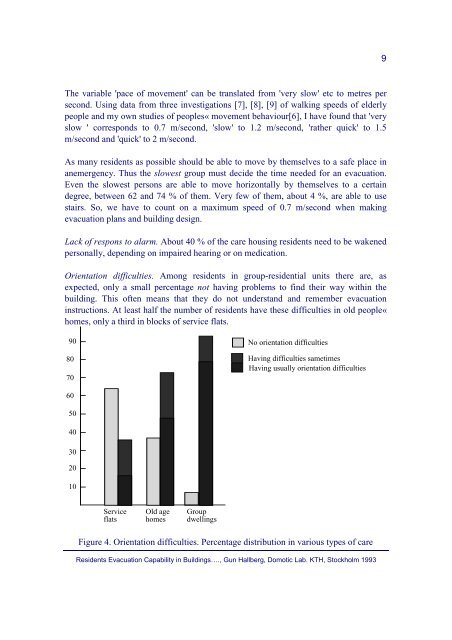Residents' Evacuation Capability in Buildings
Residents' Evacuation Capability in Buildings
Residents' Evacuation Capability in Buildings
You also want an ePaper? Increase the reach of your titles
YUMPU automatically turns print PDFs into web optimized ePapers that Google loves.
9<br />
The variable 'pace of movement' can be translated from 'very slow' etc to metres per<br />
second. Us<strong>in</strong>g data from three <strong>in</strong>vestigations [7], [8], [9] of walk<strong>in</strong>g speeds of elderly<br />
people and my own studies of peoples« movement behaviour[6], I have found that 'very<br />
slow ' corresponds to 0.7 m/second, 'slow' to 1.2 m/second, 'rather quick' to 1.5<br />
m/second and 'quick' to 2 m/second.<br />
As many residents as possible should be able to move by themselves to a safe place <strong>in</strong><br />
anemergency. Thus the slowest group must decide the time needed for an evacuation.<br />
Even the slowest persons are able to move horizontally by themselves to a certa<strong>in</strong><br />
degree, between 62 and 74 % of them. Very few of them, about 4 %, are able to use<br />
stairs. So, we have to count on a maximum speed of 0.7 m/second when mak<strong>in</strong>g<br />
evacuation plans and build<strong>in</strong>g design.<br />
Lack of respons to alarm. About 40 % of the care hous<strong>in</strong>g residents need to be wakened<br />
personally, depend<strong>in</strong>g on impaired hear<strong>in</strong>g or on medication.<br />
Orientation difficulties. Among residents <strong>in</strong> group-residential units there are, as<br />
expected, only a small percentage not hav<strong>in</strong>g problems to f<strong>in</strong>d their way with<strong>in</strong> the<br />
build<strong>in</strong>g. This often means that they do not understand and remember evacuation<br />
<strong>in</strong>structions. At least half the number of residents have these difficulties <strong>in</strong> old people«<br />
homes, only a third <strong>in</strong> blocks of service flats.<br />
90 No orientation difficulties<br />
80<br />
70<br />
Hav<strong>in</strong>g difficulties sametimes<br />
Hav<strong>in</strong>g usually orientation difficulties<br />
60<br />
50<br />
40<br />
30<br />
20<br />
10<br />
Service<br />
flats<br />
Old age<br />
homes<br />
Group<br />
dwell<strong>in</strong>gs<br />
Figure 4. Orientation difficulties. Percentage distribution <strong>in</strong> various types of care<br />
Residents <strong>Evacuation</strong> <strong>Capability</strong> <strong>in</strong> Build<strong>in</strong>gs…., Gun Hallberg, Domotic Lab. KTH, Stockholm 1993
















